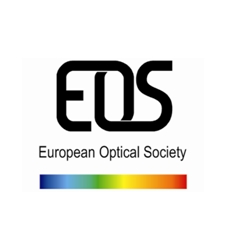Journal of the European Optical Society - Rapid publications, Vol 8 (2013)
Spatial profiling of optical gain for optimizing lasing in plasmonic nano-lasers
Abstract
Design of cylindrical metal-clad semiconductor nano-lasers is undertaken. Specific attention is given to determining the modal gain instructures supporting TM01 Surface Plasmon Polarition (SPP) modes. For representative structures it is indicated that cavity lengths oforder 100 μm enable lasing action. In comparison structures supporting TE01 core-confined modes having cavity lengths of order 10 μm may sustain lasing. The analysis methodology adopted offers means to affect the design of candidate semiconductor lasers for bespokeapplications.
© The Authors. All rights reserved. [DOI: 10.2971/jeos.2013.13045]
Citation Details
References
T. Baba, ”Photonic crystals and microdisk cavities based on GaInAsP-InP system,” IEEE J. Quantum Elect. 3, 808–830 (1997).
J. Topolancik, S. Chakravarty, P. Bhattacharya, and S. Chakrabarti, ”Electrically injected quantum-dot photonic crystal microcavity light sources,” Opt. Lett. 31, 232-234 (2006).
J. Pauzauskie, D. J. Sirbuly, and P. Yang, ”Semiconductor nanowire ring resonator laser,” Phys. Rev. Lett. 96, 1439031–1439034 (2006).
P. Yeh, Optical waves in layered media (John Wiley & Sons, New York, 1988).
D. K. Armani, T. J. Kippenberg, S. M. Spillane, and K. J. Vahala, ”Ultra-high-Q toroid microcavity on a chip,” Nature 421, 925–928 (2003).
O. Hess, J. B. Pendry, S. A. Maier, R. F. Oulton, J. M. Hamm, and K. L. Tsakmakidis, ”Active nanoplasmonic metamaterials,” Nat. Mater. 11, 573–584 (2012).
O. Hess, and K. L. Tsakmakidis, ”Metamaterials with quantum gain,” Science 339, 654–655 (2013).
A. D. Boardman, V. V. Grimalsky, Y. S. Kivshar, S. V. Koshevaya, M. Lapine, N. M. Litchinitser, V. N. Malnev, et al., ”Active and tunable metamaterials,” Laser Photonics Rev. 5, 287–307 (2011).
C. M. Soukoulis, and M. Wegener, ”Past achievements and future challenges in the development of three-dimensional photonic metamaterials,” Nat. Photonics 5, 523–530 (2011).
S. Wuestner, A. Pusch, K. L. Tsakmakidis, J. M. Hamm, and O. Hess, ”Overcoming losses with gain in a negative refractive index metamaterial,” Phys. Rev. Lett. 105, 127401–127404 (2010).
O. Hess, S. Wuestner, A. Pusch, K. L. Tsakmakidis, and J. M. Hamm, ”Gain and plasmon dynamics in active negative-index metamaterials,” Philos. T. R. Soc. A 369, 3525–3550 (2011).
J. M. Hamm, S. Wuestner, K. L. Tsakmakidis, and O. Hess, ”Theory of light amplification in active fishnet metamaterials,” Phys. Rev. Lett. 107, 167405–167409 (2011).
A. Pusch, S. Wuestner, J. M. Hamm, K. L. Tsakmakidis, and O. Hess, ”Coherent amplification and noise in gain-enhanced nanoplasmonic metamaterials: A Maxwell-Bloch Langevin approach,” ACS Nano 6, 2420–2431 (2012).
M. T. Hill, M. Marell, E. S. P. Leong, B. Smalbrugge, Y. Zhu, M. Sun, P. J. an Veldhoven, et al., ”Lasing in metal-insulatormetal sub-wavelength plasmonics waveguides,” Opt. Express 17, 11107–11112 (2009).
R. F. Oulton, V. J. Sorger, T. Zentgraf, R. M. Ma, C. Gladden, L. Dai, G. Bartal, and X. Zhang, ”Plasmon lasers at deep subwavelength scale,” Nature 461, 629–632 (2009).
K. Yu, A. Lakhani, and M. C. Wu, ”Subwavelength metal-optic semiconductor nanopatch lasers,” Opt. Express 18, 8790–8799 (2010).
M. A. Noginov, G. Zhu, A. M. Belgrave, R. Bakker, V. M. Shalaev, E. E. Narimanov, S. Stout, et al., ”Demonstration of a spaser-based nanolaser,” Nature 460, 1110–1113 (2009).
S. J. Al-Bader, and M. Imtaar, ”Azimuthally Uniform Surface-Plasma Modes in Thin Metallic Cylindrical Shells,” IEEE J. Quantum Elect. 28, 525–533 (1992).
A. V. Maslov, and C. Z. Ning, ”Size reduction of a semiconductor nanowire laser by using metal coating,” Proc. SPIE. 6468, 646801– 646807 (2007).
V. Krishnamurthy, and B. Klein, ”Theoretical investigation of metal cladding for nanowire and cylindrical micropost lasers,” IEEE J. Quantum Elect. 44, 67–74 (2008).
K. Ikeda, Y. Fainman, K. A.Shore, and H. Kawaguchi, ”Modified long-range surface plasmon polariton modes for laser nanoresonators.” J. Appl. Phys. 110, 0631061–0631066 (2011).
K. A. Shore, ”Modulation bandwidth of metal-clad semiconductor nano-lasers with cavity-enhanced spontaneous emission,” Electron. Lett. 46, 1688–1689 (2010).
J. Noborosika, J. Motohisa, J. Takeda, M. Inari, Y. Miyoshi, N. Ooike, and T. Fukui, ”Growth of GaAs and InGaAs nanowires by utilizing selective area MOVPE,” in Proceedings to 16th Int. Conf. Indium Phospide and Related Materials, (IEEE, Japan, 2004).
Y. Kim, H. J. Joyce, Q. Gao, H. H. Tan, C. Jagadish, M. Paladugu, J.Zou, and A. A. Suvorova, ”Influence of nanowire density on the shape and optical properties of ternary InGaAs nanowires,” Nano Lett: 6, 599–604 (2006).
M. A. Ordal, L. L. Long, R. J. Bell, S. E. Bell, R. R. Bell, R. W. Alexander, Jr., and C. A. Ward, ”Optical properties of metals Al, Co, Cu, Au, Fe, Pb, Ni, Pd, Pt, Ag, Ti and W in infrared and far infrared,” Appl. Opt. 22, 1099–1119 (1983).
G. Winter, S. Wedge, and W. L. Barnes, ”Can lasing at visible wavelengths be achieved using low-loss long-range surface plasmonpolariton mode?” New J. Phys. 8, 1–14 (2006).
P. Yeh, A. Yariv, and E. Marom, ”Theory of Bragg fiber,” J. Opt. Soc. Am. 68, 1196–1201 (1978).
J. J. Burke, G. I. Stegeman, and T. Tamir, ”Surface-polariton-like waves guided by thin, lossy metal films,” Phys. Rev. B. 33, 5186–5201 (1986).

